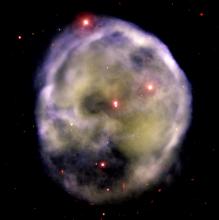Listen to today's episode of StarDate on the web the same day it airs in high-quality streaming audio without any extra ads or announcements. Choose a $8 one-month pass, or listen every day for a year for just $30.
You are here
The Whale’s Tail
A star can be both young and old at the same time. It can be young compared to other stars, yet old in terms of its own life cycle.
An example is Deneb Kaitos — a name that means “the tail of the whale.” The star marks the tail of Cetus, the whale or sea monster. The star is in the southeast at nightfall. It’s to the upper left of the only bright star in that region of the sky, Fomalhaut. Deneb Kaitos is the next-brightest star around, so it’s fairly easy to pick out.
Deneb Kaitos is a little more than a billion years old. That’s pretty young for a star. By comparison, the Sun is four and a half billion years old. And many stars are billions of years older than that.
But Deneb Kaitos has already moved out of the prime of life. That’s because of its mass — almost three times the mass of the Sun. Heavier stars burn through their nuclear fuel much faster than lighter stars, so they live shorter lives.
Deneb Kaitos has converted the original hydrogen in its core to helium. Now, it’s fusing the helium to make heavier elements. It’ll stay in that phase of life for another hundred million years, getting bigger and brighter as it does so.
When that phase is over, the star will cast its outer layers into space. For a while, it’ll surround itself with a colorful bubble of gas and dust. The bubble will quickly fade away, though. That will leave only the star’s hot but dead core — a white dwarf — and the tale of the tail of the whale will come to an end.
Script by Damond Benningfield





